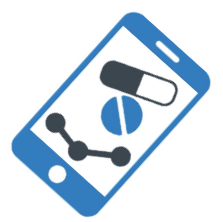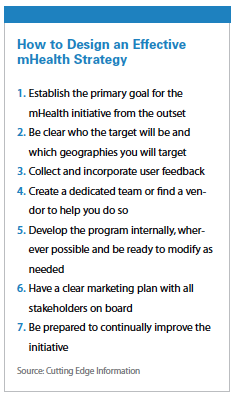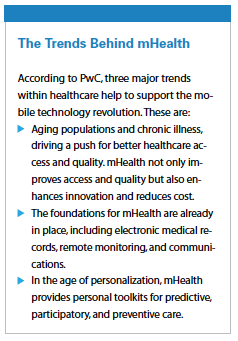Mobile is ubiquitous. Consumers use mobile apps to search for information about everything from retail products to news and sports and, increasingly, to monitor their health.
 A report from comScore found that mobile now represents 65% of digital media time, and that desktop computers are becoming the secondary touchpoint for many U.S. consumers. This is reflected globally with the International Telecommunication Union reporting that there are more than 5 billion mobile device subscribers worldwide.
A report from comScore found that mobile now represents 65% of digital media time, and that desktop computers are becoming the secondary touchpoint for many U.S. consumers. This is reflected globally with the International Telecommunication Union reporting that there are more than 5 billion mobile device subscribers worldwide.
Mobile health, or mHealth, has huge potential not only for patients, caregivers, and physicians, but also for pharmaceutical companies. A PwC study forecast that healthcare would be among the top three biggest mobile trends in 2016, and projections from research2guidance suggest global revenue from mHealth applications will reach $26.56 billion in 2017.
As regulatory authorities turn their focus to patient engagement, mHealth will become an even more important element in the health discussion. In fact, the FDA has made clear that patient engagement will be a core part of the regulatory approval process and will be embedded in the reauthorization of the Prescription Drug User Fee Act in 2017. The agency has also said it supports advances that lead to “a convergence of people, information, technology, and connectivity to improve healthcare and health outcomes."
Why mHealth?
There has been huge growth in the number of healthcare apps coming to market, but this has also led to consumer fatigue. The challenge is to develop a healthcare app that brings value in terms of direct health interventions or predictive capabilities. These benefits might include patient enrollment in clinical trials, reaching at-risk or hard-to-reach patient populations, or simply helping patients stay on top of their health management.
One area where mobile offers huge potential is precision medicine, which seeks to treat and prevent disease based on  individual variabilities — genetic, environmental, and lifestyle. In an effort to build widespread participation across multiple groups, the National Institutes of Health has awarded $1.5 million to five companies to build apps and enroll 350,000 participants as part of the Precision Medicine Initiative (PMI).
individual variabilities — genetic, environmental, and lifestyle. In an effort to build widespread participation across multiple groups, the National Institutes of Health has awarded $1.5 million to five companies to build apps and enroll 350,000 participants as part of the Precision Medicine Initiative (PMI).
Mobile apps will be used to enroll, gain consent, collect data from, and communicate with participants.
Analysis of data for patient outcomes is another area where mHealth apps could provide invaluable insight. For example, Digisight Technologies has developed an app to monitor data using vision tests for patients who participate in clinical trials.
For patients looking for guidance, regulatory approval offers perhaps the best insight. Across many governmental bodies, mHealth is starting to be taken more seriously. A prominent example is WellDoc’s BlueStar app, which was the first FDA-approved app for managing type 2 diabetes, receiving clearance in 2010. The agency has since approved many other apps and wearables.
From a global point of view, mHealth is recognized for its potential to transform health delivery. According to the GSM Association, commercial wireless signals reach more than 85% of the global population, far exceeding the reach of the electrical grid. A survey by the World Health Organization, and completed by 114 member states, found that a majority of countries offer at least one type of mHealth service, such as health call centers, managing emergencies and disasters, mobile telemedicine, health awareness raising, and decision-support systems.
In particular, mHealth is seen as an opportunity to meet health-related Millennium Development Goals, and address issues such as HIV/AIDS, malaria, and tuberculosis.
The potential of mHealth to manage serious health issues in developing nations is recognized by the NIH, which through the Fogarty International Center, has initiated a mobile health program aimed at developing mHealth tools to improve health outcomes. For example, an NIH-supported team has developed a simple iPhone app in the fight against river blindness. mHealth also has the potential to assist with public health by reaching patients at risk of contracting infectious diseases and better surveillance of the spread of disease, according to PwC.
What’s in it for Pharma?
More recently, pharmaceutical companies are starting to recognize the power of mHealth. According to research2guidance, mobile apps have several stand-out benefits for pharmaceutical companies, including helping them  reach more patients, helping those patients stay compliant, guiding patients in how to use their medication correctly, providing health-related information and education to physicians, exchanging information on results from clinical trials with physicians, improving interaction between the company and physicians, and potentially even providing an additional revenue stream.
reach more patients, helping those patients stay compliant, guiding patients in how to use their medication correctly, providing health-related information and education to physicians, exchanging information on results from clinical trials with physicians, improving interaction between the company and physicians, and potentially even providing an additional revenue stream.
A growing number of pharmaceutical companies are tapping into the opportunities mHealth presents. For example, GSK is committed to increasing use of mHealth data in its clinical trials as one way to try to reduce the cost of developing drugs. Daiichi Sankyo developed a mobile app to help patients with atrial fibrillation by providing tailored reminders to adhere to their medication. Boehringer Ingelheim has also been at the forefront with its commitment to apps to improve adherence, including a partnership with Propeller Health for a sensor that monitors adherence of COPD and asthma patients. Lilly has developed a mobile app to help patients remember to take their once-a-week diabetes medication Trulicity at the right time and how to use the injection mechanism correctly. And Takeda’s iBData program helps patients with inflammatory bowel disease track their symptoms through a smartwatch app.
Cautious Way Forward
While government agencies have demonstrated their support for mHealth to improve outcomes, the FDA also has differentiated between digital health apps that support health goals and devices that need FDA clearance.
In July 2016, the FDA’s Center for Devices and Radiological Health (CDRH) issued guidance on low risk general wellness devices. The CDRH has made clear it doesn’t intend to actively regulate products that meet the definition of low risk general wellness devices. However, any product that falls outside of the “low risk" guidance — if it’s invasive, if it’s implanted, or if the product involves an intervention or technology that may pose a risk to the safety of users and other persons if specific regulatory controls are not applied — could face the same regulations as traditional medical devices. The agency’s guidance — General Wellness: Policy for Low Risk Devices — seeks to help manufacturers determine when their devices and claims might fall into the regulated medical device arena.
As mHealth continues to grow and apps expand into different areas, the opportunities for health improvements grow, as do the complexities. Companies will need to carefully balance innovation with clear understanding of the evolving regulatory guidelines. (PV)
~~~~~~~~~~~~~~~~~~~~~~~~~
Executive viewpoints
Gavin Birchnall
Senior Product Manager,
ERT
Demand Drives Growth
One of the key drivers for the growth of mHealth is patients’ changing expectations and the increased demand for control over their own health. Society now expects technology to enhance every aspect of peoples’ lives, including healthcare, providing instant access to information and increased control. Advances in mobile and connected technology now mean individuals can monitor their health as consumers with 24/7 access to information and support.
Chris Watson, Ph.D.
Director of Product Strategy, ERT
Scaling mHealth
Disease knows no borders, so although technology can provide a cost-effective mechanism of decentralizing healthcare, scaling an mHealth pilot program into a multinational service isn’t as simple as you think. Providers face a multitude of varying regulations and differing patient requirements that must be addressed in a single solution. This, however, can be addressed through strong regional knowledge, as well as a highly adaptable technology platform that can manage services spanning multiple geographies.
Paul Greene, Ph.D.
Senior VP, Clinical Development — CNS,
INC Research
Integration is key to mHealth
A core principle in the collection of scientific data is that data about an event are always better if collected in temporal proximity. Put simply, if there is health information you want for a clinical study, it is best to collect it when it happens instead of waiting for a study visit. This might include the collection of adverse events or patient reported outcomes; it might also include the collection of sleep parameters or vital signs. In essence, this is real-time data collection and is the foundation of quality and precise data.
A primary challenge for mHealth is the integration of data and platforms. All clinical study data and data collection mechanisms need to be integrated seamlessly into the clinical database. This is not only so that everything works together, but is also an effort to simplify the site interface — one user name and password is less frustrating than five or six.
Improving clinical TrialEfficiency
The key applications for mHealth are starting to emerge. In a clinical-trial setting, mHealth can target any data that are better captured continuously versus at specified visits, and where the data collected do not require specialized skills from site staff. Devices that collect activity data are a good example of this. Analogous to the activity monitor many of us wear today, these devices use accelerometers to capture activity around the clock. However, there are also proven algorithms that transform that data to reliably characterize the quantity and quality of sleep.
In the future, we expect these devices to extend into heart rate and even blood pressure. There is some concern that these are a burden to the patient, but more often we see them as an opportunity to lessen the burden on both sites and patients. The key to success is to look for opportunities to reduce the overall number of study visits and procedures at the same time you implement mHealth devices.
Dara Liguori
Digital Engagement Strategist,
Ogilvy CommonHealth Worldwide, part of WPP Health & Wellness
Artificial intelligence to play role in mHealth future
As the market and technology mature, mHealth barriers — such as data security and platform integration — will likely resolve and adoption will increase. mHealth is poised to play a large role in the future healthcare landscape by improving healthcare quality and cost efficiency, particularly with the incorporation of artificial intelligence (AI). AI brings together structured and unstructured health data with machine learning to lay the groundwork for improvements in preventative care, personalized medicine and population health.
Brandie Linfante
VP, Digital Strategy,
Ogilvy CommonHealth Worldwide, part of WPP Health & Wellness
mHealth’s
transformative impact
The use of mHealth technologies with respect to achieving health goals and objectives can have a transformative effect on global health services. Key applications include communication between individuals (patients and/or caregivers) and healthcare providers/services, remote patient monitoring, telemedicine, and medical condition management, including treatment compliance, appointment reminders, and community mobilization. Additional key applications would include education, awareness, communication for healthcare professionals, and epidemic/disease outbreak reporting/tracking.

















